Dachshund Colors — Which Combination Would You Choose?
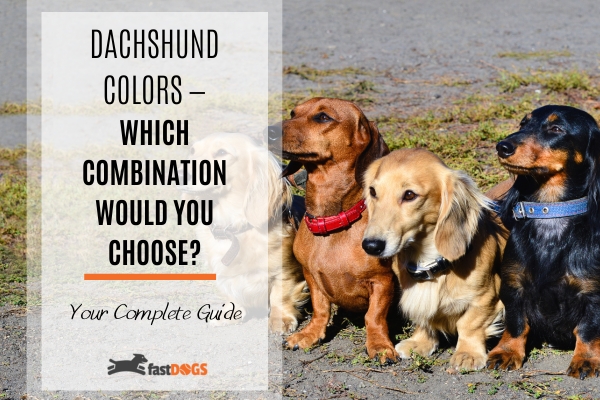
Dachshund Colors, Markings & Coat Types Explained
The loveable sausage dog — floppy eared, short legged with a long body. Yet this breed isn’t for the indecisive dog moms and dads among us.
I’m talking about coat combinations — with many Dachshund colors, this breed has such a variety to choose from. Some are so striking, they’re almost like a different breed.
Join us as we delve into the fascinating world of Wiener dog colors — exploring the different coat patterns and hues that make each Dachshund a true individual.
What Are the Dachshund Coat Types?
Before we look at the colors, another Dachshund-deciding factor is coat type — there are three to choose from:
Smooth.
Long-haired.
Wiry.
Smooth-coated Doxies are silkier to the touch and will generally be lower maintenance than the other two Dachshund coat types. The long-haired is known for their lengthy straight coat, while the wire-haired has short, curly, or coarse hair that’s prone to knotting or mats.
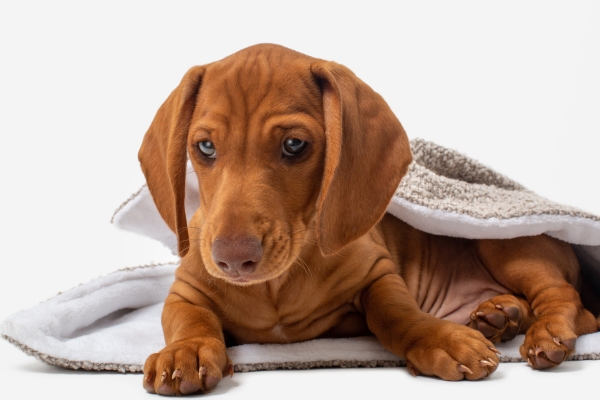
The Dachshund Colors
The AKC acknowledges 15 Dachshund colors. Yet three of them are so rare, they’re classed as “non-standard.” Hence, Dachshunds with these coat colors are also unable to take part in AKC dog shows.
The breed’s colors can be made up of either a single color or a combination of two base colors.
* non-standard color
Single Dachshund Colors
A single-colored Dachshund is exactly what the name suggests, one color without any markings, and the solid color is rich and velvety smooth.
However, the presence of solid black hairs down the back, around the ears and the tail of some single-colored Dachs can produce a slightly darker ‘shaded’ effect.
1. Red Dachshund

The most common of the Dachshund coat colors. Only a single dominant red color gene is needed to create this vibrant yet elegant rusty-brown-like red color in the Dachshund. To complete their overall look, the Red Doxie has a black nose and nails.
Solid reds don’t have any other white markings or black tints on their coat. Although, a shaded red variety also exists. The shading consists of a black overlay on their back, ears, and tail.
2. Cream Dachshund
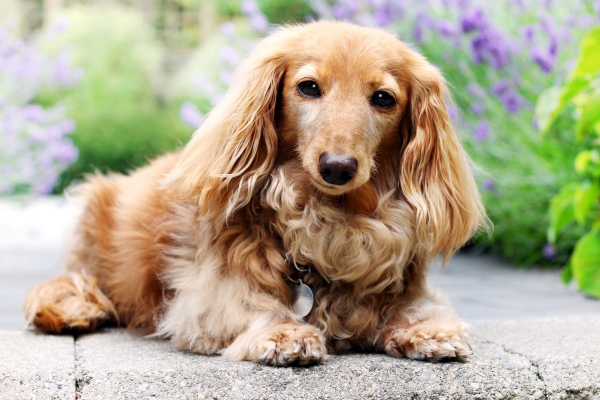
The cream-colored Dachshund is often thought to be the most elegant looking of all the different colors of Dachshunds. They have a softer appearance than many of the other variations — almost resembling a cute bunny rabbit.
Like other breeds with a cream color, their coats can either be very light (almost white) or a little darker and more of a golden cream/blonde.
This color comes in two varieties. The shaded cream has the same black accents on their coat, often found on reds. In contrast, the clear cream Dach is the result of a recessive gene that doesn’t permit the shading to develop.
3. Wheaten Dachshund
One of the rarest of all the Dachshund coat colors, the wheaten falls between whitish hues and a light golden brown — virtually the same color as wheat.
Originally this color was exclusive to wire-haired coats. However, through breed development, you can now find wheaten Doxies with smooth or long-haired coats.
4. Black Dachshund
A non-standard color according to the AKC, it’s very rare you will come across a solid black Dachshund. These dogs occasionally appear in litters, due to poor breeding practices.
Black Dachshund pups should have tan points, but in all-blacks, these have been repressed by a recessive pigment gene. This should have been spotted through DNA testing by a breeder.
5. Chocolate Dachshund
Another Dachshund color that isn’t recognized as standard is the light brown Dachshund — known as the chocolate Dach. Their luxurious earthy-hued coat can vary in intensity. These charming dogs often have brown eyes, liver-colored noses, and nails that complement their chocolate-colored fur.
Although they may look very cute, the lack of any cream or tan markings mean they don’t have the same elegant, happy-looking faces of this cute little weiner breed.
And, the AKC argues that the lack of markings, even on the ever so cute brown long haired Dachshund, excludes them from competing in any AKC-organized doggy shows.
6. Fawn Dachshund
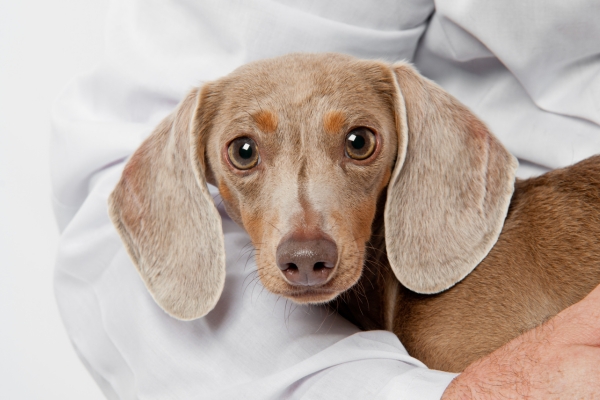
The fawn color, also known as Isabella, is a unique and rare non-standard coat color. Their fur has a diluted chocolate hue, resulting in a beautiful silvery or lavender appearance. Isabella Dachshunds are highly sought after due to their distinctive coloring.
Dilution of color can make a pooch more susceptible to color dilution alopecia, a genetic condition where they may suffer hair thinning/loss and itchy or flaky skin. Most common in blue or fawn Doxies, they’re born with a normal coat, but their hair follicles start to self-destruct — typically from the six-month mark. This results in patches of skin where no new hairs grow.Two-Colored Dachshunds
Bi-colored Dachshunds can be some of the cutest and most striking types of Dachshund colors. Below are all the officially recognized hues:
7. Wild Boar Dachshund
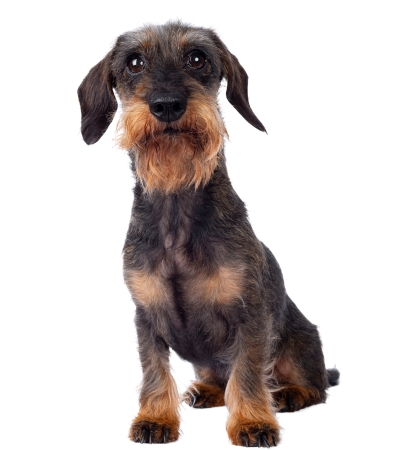
From a distance, the Dachshund wild boar is often mistaken for a black and tan Dachshund. The feet, chest and face are tan with a base coat of black fur. However, up close, the hair of the wild boar variant is also covered with goldish highlights — so, more of a tri color Dachshund!
This coloration only occurs in wire-haired and occasionally the smooth types of Dachshund coats, but never long-haired.8. Black and Cream Dachshund
Black and cream Dachshunds are a striking combination of colors that creates a visually captivating appearance. The contrast between the deep black fur and the creamy accents on their eyebrows, muzzle, chest, and legs adds to their distinctive charm.
9. Black and Tan Dachshund
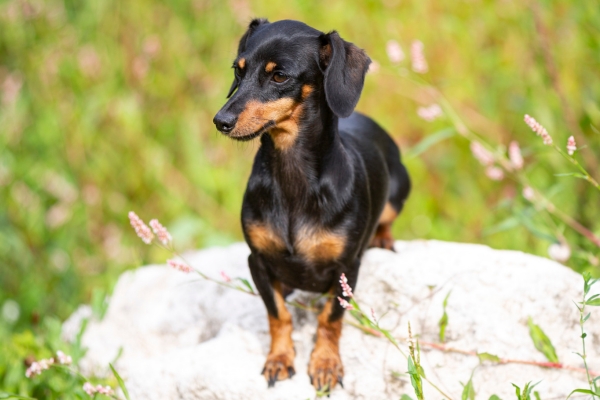
Looking like a mini Doberman (but much cuter), black and tan is another prevalent coat color in Dachshunds. This color combo typically consists of a solid black base with tan markings on the eyebrows, muzzle, chest, and legs. The contrast between black and tan creates an elegant and sophisticated look, especially on a long haired black and tan Dachshund.
10. Blue and Cream Dachshund
The blue and cream Dachshund may not be quite as flashy as the black and cream, but they can often look alike, especially if the blue is a darker tone. We’re not talking about blue, like the sky, it's closer to gray or dark silver. Blue is a diluted color that originates from black.
A gun metal blue base coat sees cream points noticeable around their eyes, on the muzzle, and over their chest, feet, and tail.
11. Blue and Tan Dachshund
Much rarer than the blue and cream Dachshunds, the base coat of the blue and tan is a similar dark metallic gray but with tan points replacing the cream. Many people often mistake the blue and tan for a blue Doberman — as they’re very similar to the untrained eye.
12. Chocolate and Cream Dachshund
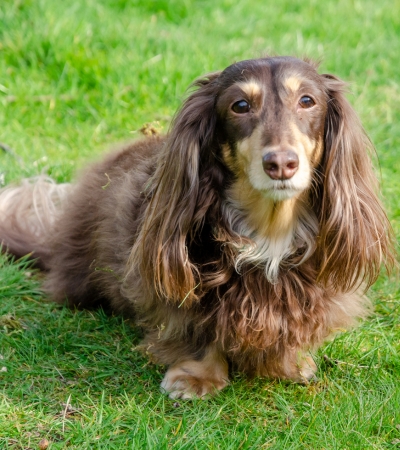
One of the most charming two-color Daschunds, with a deep chocolate-colored base coat covering their forehead, ears, back, and tail. The cream points of this little pooch range from a golden blonde to an off-white color. Those little brown and white Dachshunds you often see will be bred as chocolate and cream Dachshunds.
13. Chocolate and Tan Dachshunds
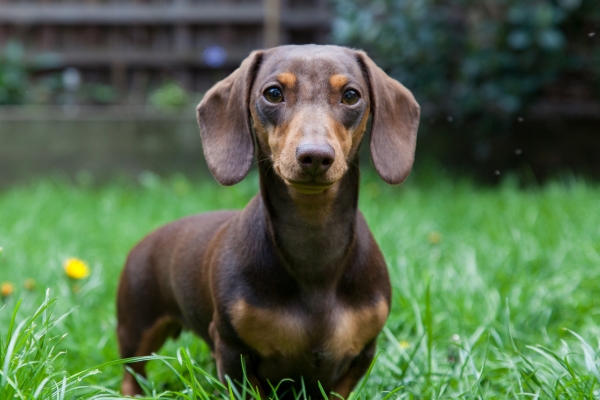
I think you probably know where we’re going with this one. The rich chocolate colors in this type of Dachshund coat combines well with dark tan points. With no black tint at all, their eyes, nose, and nails can be a shade of brown.
14. Fawn and Cream Dachshund
Often thought of as long haired Dachshund colors, fawn and cream can be present on any Dachshund coat type. That said, as fawn is a dilution of brown/chocolate, you won’t find this marking color.
Looking like a washed-out chocolate and cream pup, their nose, feet, chest, and eyebrows will be cream-colored. But, the eyes, and nails will be gray rather than black.
15. Fawn and Tan Dachshund
The fawn (Isabella) appears as a grayish-brown color on the bulk of the Doxie’s body. However, the feet, face, eyebrows, and chest will be a similar tan to that of the black and tan Dachshund, if perhaps a touch lighter.
The Dachshund Colors and Patterns
While we’ve covered the official base colors. There is one more step — Dachshund patterns.
There are four distinct patterns, which when combined with the different colors mean there can often be 30 different coat color variations.
1. Dapple
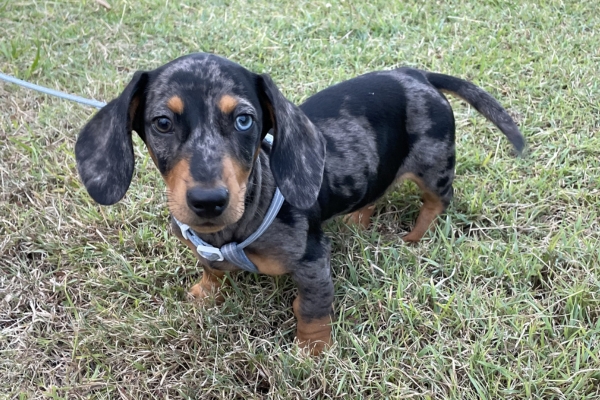
Dapple-coated Dachshunds have a marbled pattern caused by the dappling gene, merle. This recessive gene creates lighter spots or patches on a darker base coat, resulting in a visually striking and one-of-a-kind appearance.
Double dapple Dachshunds are offspring of two dapple-patterned parents. They can appear almost all-white or very light in color with just a few dapple or merle patches.
However, dapples carry many health risks — including blindness, deafness, and a higher risk of skin cancer. Double “merle” pups are often born deaf, blind, or both.
Although these patterns may impress your canine-loving buddies, the constant veterinary check-ups can be a cause of stress for both the pup and owner.
2. Brindle
Brindle Dachshunds exhibit a unique coat pattern with dark streaks or stripes on a lighter base color. These stripes can be black, brown, or a combination of both, creating a visually stunning effect.
A Brindle Piebald also exists as a distinctive marking. However, while AKC recognizes this pattern, they don’t class it as part of its standard. A mix of stripes with patches of color, these extraordinary dogs can still be a favorite among Dachshund lovers.
3. Piebald
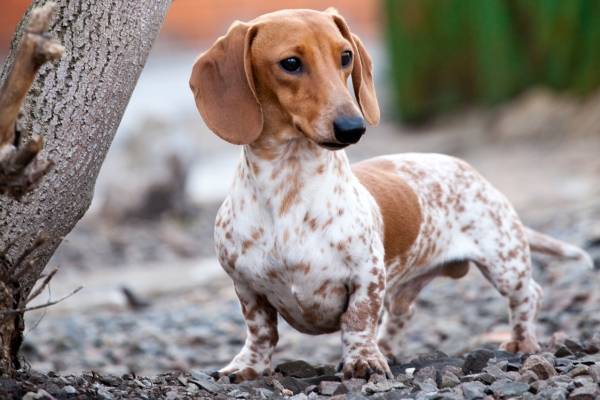
If you’ve ever seen a spotted wiener dog, it was probably the Piebald Dachshund. By its very definition Piebald or to be Pied means to be composed of incongruous parts or of different colors.
This pattern is the result of the recessive spotting gene — both parents must carry this genetic trait to produce these markings, but they don’t necessarily have to be piebald themselves. These Dachshunds end up with spotted markings, ticking on white areas, or patches of base-color, which can be mixed with any other color.
4. Sable
Sable Dachshunds have a coat pattern where individual hairs have different colors along their length — typically becoming lighter towards the body. This creates a shaded or mottled appearance. There are also a range of color variations, including red and black sable.
Final Thoughts
From the classic solid reds to the rare fawn and cream, or a spotted long haired Dachshund — each color and coat pattern adds to the Dachshund's appeal. Yet, we mustn't forget that some colors pay the price with health issues.
Whether you prefer the elegance of black and tan or the enchantment of the piebald pattern, these little weiner dogs never fail to captivate with their unique and diverse coat colors.
Which of the Dachshund colors is your favorite?Colors of Dachshunds FAQs
What Is the Rarest Dachshund Color?
Solid or all-black is the rarest — despite black being a prevalent color in many of the Dachshund’s different coat colors.
Other rare colors include fawn (Isabella), solid chocolate, or wheaten.
Do Dachshunds Change Color?
No, but their colors can fade over time or become diluted. For example, the washed-out chocolate becomes fawn, or the black in a black and tan can become a faded gray or blue.
Why Do Dachshunds Have So Many Different Colors?
The Dachshund has two main coat pigments, eumelanin — is black by default, and pheomelanin is red. Certain genes that make up the chromosomes of the Dachshund will alter these pigment concentrations. This in turn, changes the hairs of a coat to different colors.
What Color Does a Mini Dachshund Come In?
Mini Dachshund colors are the same as the Standard Dachshund — detailed above.
What Color is Isabella Dachshund?
An Isabella Dachshund is a light brown or fawn color, often referred to as lilac in other breeds. The color comes from a recessive gene carried by both parents, which causes the dilution of chocolate to this lighter shade. Normally an Isabella will have a gray or brown nose, paw pads, and nails to go with that sleek coat.
Can a Dachshund Be All Black?
Solid black is very rare, but it can occur in all coat types. Normally it’s not down to breeding, but when the Dachshund is lacking the tan gene.
Which Dachshund Colors Are Prone to Health Issues?
Blue and fawn (Isabella) are the two Dachshund colors more likely to suffer from chronic or hereditary illnesses, including:
Color dilution alopecia — heightening risk of skin cancer.
Sight problems — glaucoma, cataracts, blindness.
Dachshund patterns, like double dapples and piebalds are also predisposed to medical conditions — typically related to their eyes and ears:
Blindness.
Deafness.
